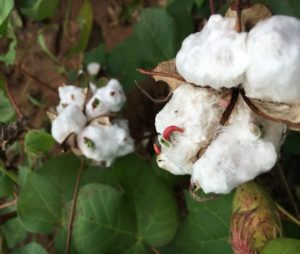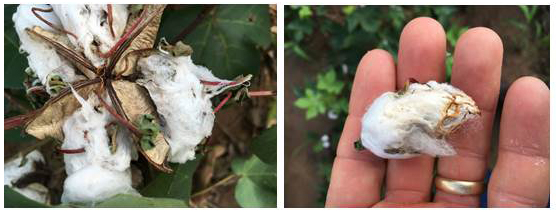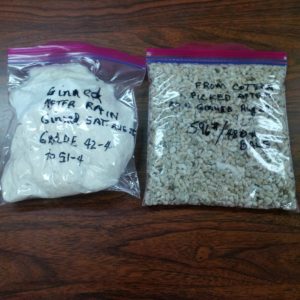by Gaylon Morgan, Texas A&M AgriLife Extension Service
The 2016 season has been a continuous challenge for the cotton producers in the Upper Gulf Coast and Blacklands of Texas. Through the planting and establishment challenges of a very wet spring and decreased fruit retention from a very dry June, July, and early August, everyone was ready to harvest and get the cotton harvested and to the gin. Then, came the string of days and now weeks of more-or-less continuous rain the Upper Gulf Coast, and to a slightly lesser extent in the Blacklands. After a week straight of rain, by August 22, the whole cotton industry was in a bit of panic with seed sprouting widespread across both regions. At the time, we knew the seed quality (oil content) was going to be down, ginning was going to slow, and that color grade were going to cause discounts. We just did not and do not know to what extent the damage will be until the cotton is harvested and ginned.
Unfortunately, the rain has continued to fall in some areas over the past two weeks, further decreasing fiber and seed quality, and further delaying harvest. Although not much cotton has been ginned or classed, most recent lint and seed quality reports from the gins are not as bad as many expected. Hopefully, we will have some dry weather, and we will be able to look forward rather that backwards at this 2016 crop.
Below are couple of topics that should help the growers make some decisions moving forward.
Harvest considerations moving forward:
This is not our first time to go through such an event, and unfortunately it probably will not be our last. It is always worse when it happens to ourselves, but this situation happens every couple of years somewhere in one of the 17 states of the Cotton Belt. So, there is some information available for us to learn from. See links below. The take home message from all these articles is: It is critically important to allow the cotton lint, seed (or what’s left), and other plant material (cotylendons, leaves, etc.) be adequately dry (lint at 8% and seed below 12%) at the time of harvest. Otherwise, lint and seed quality will further degrade in the module or roundbale. The article developed by Cotton Incorporated on picker harvest recommendation included a section titled “Timing Field Operations/Moisture Considerations” that will be useful to keep in mind when trying to decide when to harvest a field. Also, our friends in the Southeastern U.S. dealt with a similar situation in 2015. Here are some links to articles that my colleagues developed or contributed to last fall. See “Cotton Quality Affected by Late Rainfall” in Aganytime.com and “Seed Sprouting Observed” by NCSU Extension.
Harvest-aid considerations moving forward:
With the excessive moisture and significant vegetative regrowth, many are starting over trying to defoliate the cotton to prepare for harvest. From recent harvest-aid trials, both Folex (6-8 oz/a) and Ginstar (3-4 oz/a) in combination with 1.6-2.4 oz/a of Dropp (Thidiazuron) have provided good control of the young vegetative regrowth, but was less effective than expected on the mature leaves. The PPO products will work well on small regrowth also and will provide some “drying down” affect. Paraquat is the least effective option for removing the small immature regrowth leaves, but is still an effective option to desiccate prior to stripping cotton.
Cotton lint quality considerations:
Excessive rain and subsequent weathering are known to cause reductions in lint weight and also quality grades. Lint losses can be attributed to leaching, microbial activity, and actual losses in the ginning process. Quality losses can affect most of the grading parameters including staple, strength, micronaire, leaf, and, especially, color grade. As a reminder, color classifications can indicate problems with the cotton during the spinning and dyeing process further down the road. It remains important to harvest seed cotton as dry as possible, and it is even possible for lint to “bleach out” in sunlight and improve color grade. Again, excessive rainfall is a recurring problem in the Cotton Belt, and another good resource is a National Cotton Council publication from 1992, which includes the chart below, “Boll Weathering (and) Effect of Rainfall on Yield and Grade Index”.
So far, not much of the rained-on cotton has been ginned and classed to date. So we are unsure how severe the situation will be. As a reference point, USDA has classed 396,509 bales in Texas through September 1, 2016. Most of this cotton is from the Coastal Bend and RGV that had little rain. So far though Sept 1, 98.4% classed Grade 32 or better and 94.8% classed Leaf 4 or better. You can find all classing data by state and classing office at https://www.marketnews.usda.gov/mnp/cn-home
Cottonseed quality considerations:
Cottonseed is normally graded for quality using many parameters before being delivered to the oil mill. Of these parameters, Foreign Material, Moisture, and Free Fatty Acids (FFA) are highly influenced by excessive rain and low FFA are a key component for maintaining oil quality. We know that cottonseed value has decreased, especially from the oil content perspective. However, the feed value is less susceptible to the effects of weather than the oil value. Much of our cottonseed goes to livestock feed anyway, and hopefully, the impact of the weather cottonseed will not result in significant discounts. To minimize further loss of cottonseed quality, it is very important that the harvested cotton is sufficiently dry. The article titled “Recommendations for Handling Seedcotton Exposed To Excessive Rainfall” by the National Cotton Council provides a lot of good information on management recommendations to maintain cottonseed quality. Also, if you are interested in the specifics of cottonseed grades, the information can be found in the article titled “Trading Rules for Feed Grade Cottonseed” by Cotton Incorporated. Last, much of our cottonseed goes into dairy industry. An article titled “Performance and Ruminal Fermentation of Dairy Cows Fed Whole Cottonseed with Elevated Concentrations of Free Fatty Acids in the Oil” provides some additional information on cottonseed. In this article, they reported minimal detrimental impacts from higher levels of Free Fatty Acids, even at the upper teen levels. However, with high moisture cottonseed other concerns exist, such as mycotoxins, storability, bound protein. Alflatoxins have not typically be a major problem in Texas’ cotton production, and there have been no reports of high aflatoxin levels from the Blacklands or Upper Gulf Coast thus far this year. However, rainfall when bolls are open does increase the likelihood of high aflatoxin levels. There is was a survey of aflatoxins in South Texas reported in the article “Aflatoxin Contamination of Commercial Cottonseed in South Texas” by Jaime-Garcia and Cotty. Hopefully, aflatoxin will not be an additional element for us to deal with, but we wanted you to have some information, if it did become a problem.
Summary of the Harvest Season, so far:
Over the past couple of weeks, we have taken and received many phone calls, pictures, comments from producers, ginners, and oil mill. Below are some pictures and comments to go with some of the pictures that we have received. Although each situation is different, these pictures will be helpful in documenting this difficult situation. More pictures are welcome. See below.

Figure 1. Seeds germinating in the cotton boll on August 20th after six consecutive days of rain. Picture by William Z. Morgan, 2016.

Figure 2. Same field as the above picture (Figure 1), after 3 days without rain, but with high humidity. Notice the cotyledons and roots desiccating and the saining caused by the germinated seed. Picture taken on August 25, 2016 by Gaylon Morgan.

Figure 3. Before and after pictures of seed sprouted cotton after it had been processed through a small 10 saw table-top gin. The cotton was hand harvested after about 8 days of wet weather, followed by 2-3 dry days, then ginned. The pictures are from Hill County on August 23, 2016 by Zach Davis and Ryan Janek.

Figure 4. Cotton Seed that was ginned before and after the extended wet period in Upper Gulf Coast. Picture is compliments of Dwight Jackson.

Figure 5. Cotton seed and lint sample that was commercially ginned before and after the extended wet period in Upper Gulf Coast. Picture is compliments of Dwight Jackson.

Figure 6. Cotton harvested after 2 weeks of rain. Note the change in color grades ranging from of 42-4 to 51-4 compared to an average grade of 21.2. Seed is discolored compared to pre-rain cotton, and it is believed that seed weights per bale will decrease as harvest progresses. The cotton seed weight for this sample was 596 lb/480 lb bale. Picture is compliments of United Ag in El Campo.

Dr. Gaylon Morgan, State Extension Cotton Specialist College Station, TX 979-845-2425 gdmorgan@tamu.edu
